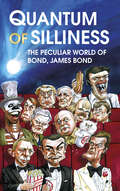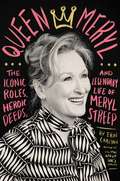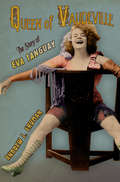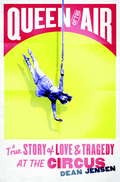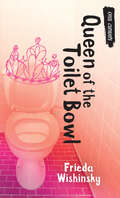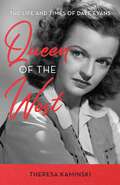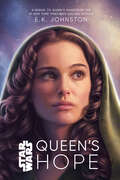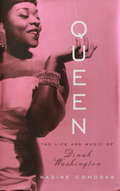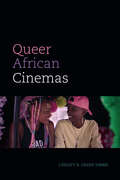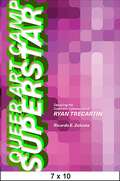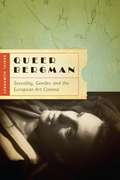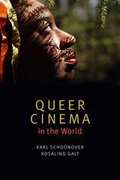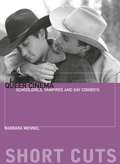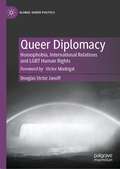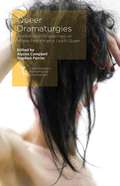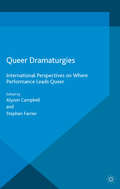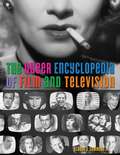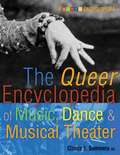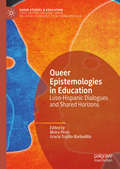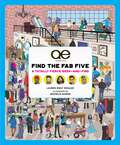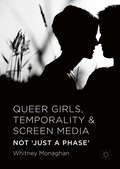- Table View
- List View
Quantum of Silliness: The Peculiar World of Bond, James Bond
by Robbie SimsWho gives the hammiest performance in a Bond film? What is the series’ most cringeworthy moment? What quips would Sir Roger Moore come out with if he starred in Licence to Kill? These are the sort of questions you never knew you needed answering. It’s Bond, James Bond – but as you’ve never seen him before.
Queen Meryl: The Iconic Roles, Heroic Deeds, and Legendary Life of Meryl Streep
by Erin CarlsonA captivating and inspiring portrait of legendary actress Meryl Streep and her work, Queen Meryl explores the fearless icon's trailblazing roles in film, her feminist activism, and the indelible mark she's left on pop culture.Meryl Streep is the most celebrated actress of our time. She's a chameleon who disappears fully into each character she plays. She never tackles the same role twice. Instead, she leverages her rarified platform to channel a range of dynamic, complicated women--Joanna Kramer, Karen Silkwood, Julia Child, Margaret Thatcher, Katharine Graham--rather than limit herself to marginal roles for which other actresses must settle: Supportive Wife. Supportive Mother. Supportive Yet Utterly Disposable Love Interest. Streep will have none of that.The once-awkward, frizzy-haired suburban teen blossomed into a rising ingénue on the stage at Vassar College and the Yale School of Drama. She came of age during the women's movement of the '60s and '70s, and has worn her activism on her sleeve even when it was unfashionable. When she reached 40, the age when many leading ladies fade away, Streep plunged forward, taking her pick of parts that interested her and winning a pile of awards along the way. Meanwhile, she remained an unlikely box-office draw, her clout even managing to grow with age: The Devil Wears Prada, starring Streep as the Anna Wintour avatar Miranda Priestly, scored $326 million worldwide.Journalist and author Erin Carlson documents all of Streep's Oscars, accents, causes, memes, friendships, and feuds; also exploring the "off-brand" forays into action-adventure (The River Wild) and musicals (Mamma Mia!), and how Streep managed to sneak her feminism into each character. In the spirit of nontraditional bestsellers like Notorious RBG and The Tao of Bill Murray, Queen Meryl is illustrated by artist Justin Teodoro and filled with fascinating lists and sidebars, delivering joy in homage to its unique and brilliant subject.
Queen of Vaudeville: The Story of Eva Tanguay
by Andrew ErdmanIn her day, Eva Tanguay (1879-1947) was one of the most famous women in America. Widely known as the "I Don't Care Girl"-named after a song she popularized and her independent, even brazen persona-Tanguay established herself as a vaudeville and musical comedy star in 1904 with the New York City premiere of the show My Lady-and never looked back. Tanguay was, at the height of a long career that stretched until the early 1930s, a trend-setting performer who embodied the emerging ideal of the bold and sexual female entertainer. Whether suggestively singing songs with titles like "It's All Been Done Before But Not the Way I Do It" and "Go As Far As You Like" or wearing a daring dress made of pennies, she was a precursor to subsequent generations of performers, from Mae West to Madonna and Lady Gaga, who have been both idolized and condemned for simultaneously displaying and playing with blatant displays of female sexuality.In Queen of Vaudeville, Andrew L. Erdman tells Eva Tanguay's remarkable life story with verve. Born into the family of a country doctor in rural Quebec and raised in a New England mill town, Tanguay found a home on the vaudeville stage. Erdman follows the course of her life as she amasses fame and wealth, marries (and divorces) twice, engages in affairs closely followed in the press, declares herself a Christian Scientist, becomes one of the first celebrities to get plastic surgery, loses her fortune following the Wall Street Crash of 1929, and receives her last notice, an obituary in Variety. The arc of Tanguay's career follows the history of American popular culture in the first half of the twentieth century. Tanguay's appeal, so dependent on her physical presence and personal charisma, did not come across in the new media of radio and motion pictures. With nineteen rare or previously unpublished images, Queen of Vaudeville is a dynamic portrait of a dazzling and unjustly forgotten show business star.
Queen of the Air
by Dean N. JensenA true life Water for Elephants, Queen of the Air brings the circus world to life through the gorgeously written, true story of renowned trapeze artist and circus performer Leitzel, Queen of the Air, the most famous woman in the world at the turn of the 20th century, and her star-crossed love affair with Alfredo Codona, of the famous Flying Codona Brothers.Like today's Beyonce, Madonna, and Cher, she was known to her vast public by just one name, Leitzel. There may have been some regions on earth where her name was not a household expression, but if so, they were likely on polar ice caps or in the darkest, deepest jungles. Leitzel was born into Dickensian circumstances, and became a princess and then a queen. She was not much bigger than a good size fairy, just four-foot-ten and less than 100 pounds. In the first part of the 20th century, she presided over a sawdust fiefdom of never-ending magic. She was the biggest star ever of the biggest circus ever, the Ringling Bros. and Barnum & Bailey Circus, The Greatest Show on Earth. In her life, Leitzel had many suitors (and three husbands), but only one man ever fully captured her heart. He was the handsome Alfredo Codona, the greatest trapeze flyer that had ever lived, the only one in his time who, night after night, executed the deadliest of all big-top feats, The Triple--three somersaults in midair while traveling at 60 m.p.h. The Triple, the salto mortale, as the Italians called it, took the lives of more daredevils than any other circus stunt.
Queen of the Air
by Dean N. JensenA true life Water for Elephants, Queen of the Air brings the circus world to life through the gorgeously written, true story of renowned trapeze artist and circus performer Leitzel, Queen of the Air, the most famous woman in the world at the turn of the 20th century, and her star-crossed love affair with Alfredo Codona, of the famous Flying Codona Brothers.Like today's Beyonce, Madonna, and Cher, she was known to her vast public by just one name, Leitzel. There may have been some regions on earth where her name was not a household expression, but if so, they were likely on polar ice caps or in the darkest, deepest jungles. Leitzel was born into Dickensian circumstances, and became a princess and then a queen. She was not much bigger than a good size fairy, just four-foot-ten and less than 100 pounds. In the first part of the 20th century, she presided over a sawdust fiefdom of never-ending magic. She was the biggest star ever of the biggest circus ever, the Ringling Bros. and Barnum & Bailey Circus, The Greatest Show on Earth. In her life, Leitzel had many suitors (and three husbands), but only one man ever fully captured her heart. He was the handsome Alfredo Codona, the greatest trapeze flyer that had ever lived, the only one in his time who, night after night, executed the deadliest of all big-top feats, The Triple--three somersaults in midair while traveling at 60 m.p.h. The Triple, the salto mortale, as the Italians called it, took the lives of more daredevils than any other circus stunt.
Queen of the Toilet Bowl (Orca Currents)
by Frieda WishinskyWhen Renata is chosen to play the lead role in the school musical, students who used to ignore her start saying hello and congratulating her in the hall. Renata enjoys her newfound acceptance at school until she realizes that Karin, a wealthy girl who expected to get the lead role, will go to great lengths to punish Renata for her success. Renata is not going to give up the role, but how much tormenting will she have to take? This short novel is a high-interest, low-reading level book for middle-grade readers who are building reading skills, want a quick read or say they don’t like to read!
Queen of the West: The Life and Times of Dale Evans
by Theresa KaminskiThis is the first full-length biography of this mid-twentieth century multi-faceted star, one that also charts the broad sweep of changes in women&’s lives during the twentieth century, and to have popular music, movies, and television shows as its backdrops. The glitter of country music, the glamour of Hollywood, and the grit of the early television industry are all covered. It is the first book to draw from never-before-seen sources (especially business records and fan mail) at the newly-opened Roy Rogers-Dale Evans collections at the Autry Museum of the American West. One of the central tensions of Dale&’s life revolved around chasing the elusive work/family balance, making her story instantly relateable to women today. In addition to fame, Dale longed for a happy, stable, family life. Her roles as wife and mother became the foundation for her public persona: the smart, smiling, cheerful cowgirl. Unusual for its time were Dale Evans&’s attempts to control the trajectory of her career at a time when men dominated decision-making in the entertainment fields.
Queen's Hope
by E.K. JohnstonA peace-loving senator faces a time of war in another thrilling Padmé Amidala adventure from the author of the New York Times best-sellers Queen's Peril and Queen's Shadow! Padmé is adjusting to being a wartime senator during the Clone Wars. Her secret husband, Anakin Skwyalker, is off fighting the war, and excels at being a wartime Jedi. In contrast, when Padmé gets the opportunity to see the casualties on the war-torn front lines, she is horrified. The stakes have never been higher for the galaxy, or for the newly-married couple. Meanwhile, with Padmé on a secret mission, her handmaiden Sabé steps into the role of Senator Amidala, something no handmaiden has done for an extended period of time. While in the Senate, Sabé is equally horrified by the machinations that happen there. She comes face to face with a gut-wrenching decision as she realizes that she cannot fight a war this way, not even for Padmé. And Chancellor Palpatine hovers over it all, manipulating the players to his own ends…
Queen: The Life and Music of Dinah Washington
by Nadine CohodasIn this biography of jazz singer Dinah Washington (1924-1963), Cohodas traces her life as a child in Tuscaloosa, Alabama, the beginnings of her career when she sang with Lionel Hampton's band, recordings and songs, and her performances with her trio, as a soloist, and other groups. A discography is provided. Cohodas is the author of other books on music and politics. Annotation ©2006 Book News, Inc. , Portland, OR (booknews. com)
Queer African Cinemas (a Camera Obscura book)
by Lindsey B. Green-SimmsIn Queer African Cinemas, Lindsey B. Green-Simms examines films produced by and about queer Africans in the first two decades of the twenty-first century in an environment of increasing antiqueer violence, efforts to criminalize homosexuality, and other state-sanctioned homophobia. Green-Simms argues that these films not only record the fear, anxiety, and vulnerability many queer Africans experience; they highlight how queer African cinematic practices contribute to imagining new hopes and possibilities. Examining globally circulating international art films as well as popular melodramas made for local audiences, Green-Simms emphasizes that in these films queer resistance—contrary to traditional narratives about resistance that center overt and heroic struggle—is often practiced from a position of vulnerability. By reading queer films alongside discussions about censorship and audiences, Green-Simms renders queer African cinema as a rich visual archive that documents the difficulty of queer existence as well as the potentials for queer life-building and survival.
Queer Art Camp Superstar: Decoding the Cinematic Cyberworld of Ryan Trecartin (SUNY series, Horizons of Cinema)
by Ricardo E. ZuluetaHailed as "the most consequential artist to have emerged since the nineteen-eighties," American artist and filmmaker Ryan Trecartin has received numerous accolades for his kaleidoscopic, multilayered movies and multimedia installations. However, there exists to date no comprehensive study of this prolific artist's work. Queer Art Camp Superstar compensates for this absence of sustained critical analysis of Trecartin's work by looking closely at a selection of his most significant movies in order to discern the artist's artistic genealogy, evolving aesthetics, radical approach to digital and Internet culture, and impact on contemporary art, film, and media.Examining Trecartin's substantial body of work, spanning from his early, pre-YouTube era series Early Baggage (2001–2003) to Temple Time (2016), Ricardo E. Zulueta adheres to a faithful chronological order, thus inviting readers to witness the ways thematic and formal concerns have evolved from Trecartin's earliest movies to his more recent multimedia cinematic installations. Through precisely chosen screen captures extracted directly from the movies, Zulueta demonstrates the serious attention paid to camera angles, mise-en-scène, and shot transitions, thus revealing and reflecting on the concepts that underwrite and are underwritten in these narratives. Giving careful attention to Trecartin's network of layered references to the grotesque and abject, carnivalesque and ludic, and camp imagery, Zulueta illustrates and explains how the artist takes on reality television, technology, fashion, consumption, and cyberspace.
Queer Bergman: Sexuality, Gender, and the European Art Cinema
by Daniel HumphreyOne of the twentieth century's most important filmmakers--indeed one of its most important and influential artists--Ingmar Bergman and his films have been examined from almost every possible perspective, including their remarkable portrayals of women and their searing dramatizations of gender dynamics. Curiously however, especially considering the Swedish filmmaker's numerous and intriguing comments on the subject, no study has focused on the undeniably queer characteristics present throughout this nominally straight auteur's body of work; indeed, they have barely been noted. Queer Bergman makes a bold and convincing argument that Ingmar Bergman's work can best be thought of as profoundly queer in nature. Using persuasive historical evidence, including Bergman's own on-the-record (though stubbornly ignored) remarks alluding to his own homosexual identifications, as well as the discourse of queer theory, Daniel Humphrey brings into focus the director's radical denunciation of heteronormative values, his savage and darkly humorous deconstructions of gender roles, and his work's trenchant, if also deeply conflicted, attacks on homophobically constructed forms of patriarchic authority. Adding an important chapter to the current discourse on GLBT/queer historiography, Humphrey also explores the unaddressed historical connections between post-World War II American queer culture and a concurrently vibrant European art cinema, proving that particular interrelationship to be as profound as the better documented associations between gay men and Hollywood musicals, queer spectators and the horror film, lesbians and gothic fiction, and others.
Queer Cinema in the World
by Rosalind Galt Karl SchoonoverProposing a radical vision of cinema's queer globalism, Karl Schoonover and Rosalind Galt explore how queer filmmaking intersects with international sexual cultures, geopolitics, and aesthetics to disrupt dominant modes of world making. Whether in its exploration of queer cinematic temporality, the paradox of the queer popular, or the deviant ecologies of the queer pastoral, Schoonover and Galt reimagine the scope of queer film studies. The authors move beyond the gay art cinema canon to consider a broad range of films from Chinese lesbian drama and Swedish genderqueer documentary to Bangladeshi melodrama and Bolivian activist video. Schoonover and Galt make a case for the centrality of queerness in cinema and trace how queer cinema circulates around the globe-institutionally via film festivals, online consumption, and human rights campaigns, but also affectively in the production of a queer sensorium. In this account, cinema creates a uniquely potent mode of queer worldliness, one that disrupts normative ways of being in the world and forges revised modes of belonging.
Queer Cinema: Schoolgirls, Vampires, and Gay Cowboys
by Barbara MennelQueer Cinema: Schoolgirls, Vampires, and Gay Cowboys illustrates queer cinematic aesthetics by highlighting key films that emerged at historical turning points throughout the twentieth century. The book traces the representation of gays and lesbians from the sexual liberation movements of the roaring 1920s in Berlin to the Stonewall Rebellion in New York City and the emergence of queer activism and film in the early 1990s. The book explains early tropes of queerness, such as the boarding school or the vampire, and describes the development of camp from 1950s Hollywood to underground art of the late 1960s in New York City. It concludes with an exploration of the contemporary mainstreaming of gay and lesbian films and global queer cinema. Queer Cinema: Schoolgirls, Vampires and Gay Cowboys thus offers an introduction to a gay and lesbian film history, but also contributes to an academic discussion about queer subversion of mainstream film.
Queer Cinema: Schoolgirls, Vampires, and Gay Cowboys (Short Cuts)
by Barbara MennelQueer Cinema: Schoolgirls, Vampires, and Gay Cowboys illustrates queer cinematic aesthetics by highlighting key films that emerged at historical turning points throughout the twentieth century. Barbara Mennel traces the representation of gays and lesbians from the sexual liberation movements of the roaring 1920s in Berlin to the Stonewall Rebellion in New York City and the emergence of queer activism and film in the early 1990s. She explains early tropes of queerness, such as the boarding school or the vampire, and describes the development of camp from 1950s Hollywood to underground art of the late 1960s in New York City. Mennel concludes with an exploration of the contemporary mainstreaming of gay and lesbian films and global queer cinema. Queer Cinema: Schoolgirls, Vampires and Gay Cowboys not only offers an introduction to a gay and lesbian film history, but also contributes to an academic discussion about queer subversion of mainstream film.
Queer Diplomacy: Homophobia, International Relations and LGBT Human Rights (Global Queer Politics)
by Douglas Victor JanoffThis book is the first study of multilateral LGBT human rights diplomacy viewed from the perspective of its practitioners: diplomats, LGBT activists, human rights experts and multilateral specialists. It demonstrates how diplomats and advocates work to promote LGBT rights on the world stage, often using Western constructs of sexual and gender identity. In turn, these efforts have triggered conflict and polarization: opposing states often deploy cultural, religious and moral discourses to minimize LGBT rights as a “legitimate” human right. The author, a seasoned Canadian foreign service officer, human rights negotiator and former community activist and researcher, uses insider perspectives to critically assess both bilateral and multilateral diplomatic engagement on LGBT human rights issues. Janoff’s research involved participation in UN meetings in Geneva and New York and 29 interviews with diplomats, human rights advocates and experts, and representatives from the UN and other inter-governmental organizations. Although LGBT issues have been mainstreamed into many areas of bilateral and multilateral human rights policy, his research found a considerable gap: a coordinated diplomatic and civil society approach is needed to more effectively address ongoing human rights violations against LGBT people around the world.
Queer Dramaturgies: International Perspectives on Where Performance Leads Queer (Contemporary Performance InterActions)
by Alyson Campbell Stephen FarrierThis international collection of essays forms a vibrant picture of the scope and diversity of contemporary queer performance. Ranging across cabaret, performance art, the performativity of film, drag and script-based theatre it unravels the dynamic relationship performance has with queerness as it is presented in local and transnational contexts.
Queer Dramaturgies: International Perspectives on Where Performance Leads Queer (Contemporary Performance InterActions)
by Alyson Campbell Stephen FarrierThis international collection of essays forms a vibrant picture of the scope and diversity of contemporary queer performance. Ranging across cabaret, performance art, the performativity of film, drag and script-based theatre it unravels the dynamic relationship performance has with queerness as it is presented in local and transnational contexts.
Queer Encyclopedia of Film and Television
by Claude J. SummersFrom Hollywood films to TV soap operas, from Vegas extravaganzas to Broadway theater to haute couture, this comprehensive encyclopedia contains over 200 entries and 200 photos that document the irrepressible impact of queer creative artists on popular culture.How did Liberace&’s costumes almost kill him? Which lesbian comedian spent her high school years as &“the best white cheerleader in Detroit?&” For these answers and more, fans can dip into The Queer Encyclopedia of Film, Theater, and Popular Culture. Drawn from the fascinating online encyclopedia of queer arts and culture, www.glbtq.com — which the Advocate dubbed &“the Encyclopedia Brittaniqueer&” — this may be the only reference book in which RuPaul and Jean Cocteau jostle for space. From the porn industry to the Sisters of Perpetual Indulgence, from bodybuilding to Dorothy Arzner, it&’s a queer, queer world, and The Queer Encyclopedia is the indispensable guide: readable, authoritative, and concise. And perfect to read by candelabra. (The answers to the two questions above: from the dry cleaning fumes, Lily Tomlin.)
Queer Encyclopedia of Music, Dance, and Musical Theater
by Claude J. SummersAficionados of music, dance, opera, and musical theater will relish this volume featuring over 200 articles showcasing composers, singers, musicians, dancers, and choreographers across eras and styles.Read about Hildegard of Bingen, whose Symphonia expressed both spiritual and physical desire for the Virgin Mary, and George Frideric Handel, who not only created roles for castrati but was behind the Venetian opera's preoccupations with gender ambiguity. Discover Alban Berg&’s Lulu, opera&’s first openly lesbian character. And don&’t forget Kiss Me Kate, the hit 1948 Broadway musical: written by Cole Porter, married though openly gay; directed by John C. Wilson, Noël Coward's ex-lover; and featuring Harold Lang, who had affairs with Leonard Bernstein and Gore Vidal.No single volume has ever achieved the breadth of this scholarly yet eminently readable compendium. It includes overviews of genres as well as fascinating biographical entries on hundreds of figures such as Peter Tchaikovsky, Maurice Ravel, Sergei Diaghilev, Bessie Smith, Aaron Copland, Stephen Sondheim, Alvin Ailey, Rufus Wainwright, and Ani DiFranco.
Queer Epistemologies in Education: Luso-Hispanic Dialogues and Shared Horizons (Queer Studies and Education)
by Moira Pérez Gracia Trujillo-BarbadilloThis edited collection brings together the work of researchers and educators from Argentina, Brazil, Spain, Colombia, Costa Rica, Portugal,and Mexico on education, pedagogy, and research from a queer perspective. It offers a space for the dissemination and development of new lines of analysis and intervention in the field of Queer Pedagogies in the region, relevant to the present and future of the field both in our countries and beyond. Chapters provide perspectives aware of the regional context but relevant from a theoretical and practical perspective beyond Ibero-America. The volume covers elementary, middle, and higher education, formal and informal, and includes theoretical and applied contributions on a variety of topics including public policies on education, queer youth, sex education, and conservative attacks against "gender ideology" in the region.
Queer Eye: A Totally Fierce Seek-and-Find
by Lauren Emily WhalenWhere's the Fab Five? At a pride parade? Remodeling a house? At a thrift shop? Find all five members of the cast of Queer Eye—plus Neon the dog and additional hidden items—in more than a dozen unique settings within this original and officially licensed search-and-find activity book. Search for the beloved cast of Queer Eye—plus Antoni&’s adorable pooch, Neon—in more than a dozen fun settings within this original officially licensed search-and-find activity book inspired by the Fab Five and their unique areas of expertise. This book also invites you to look for additional items and accessories within each fully illustrated scene. Can you spot JVN&’s missing heel? How about Antoni&’s bandana? Good luck, queen! © 2023 Scout Productions, Inc. All Rights Reserved.
Queer Eye: Love Yourself, Love Your Life
by Antoni Porowski Tan France Jonathan Van Ness Bobby Berk Karamo BrownFrom the Fab Five - the beloved hosts of Netflix's viral hit Queer Eye - comes a book, and an official guide, that is at once a behind-the-scenes exclusive, a practical guide to living and celebrating your best life, and a symbol of hope.Feeling your best is about far more than deciding what colour to paint your accent wall or how to apply nightly moisturiser. It's also about creating a life that's well-rounded, filled with humour and understanding and most importantly, that suits you. At a cultural moment when we are all craving people to admire, Queer Eye offers hope and acceptance. After you get to know the Fab Five, together they will guide you through five practical chapters that go beyond their designated areas of expertise (food & wine, fashion, grooming, home decor, and culture), touching on topics like wellness, entertaining, and defining your personal brand, and complete with bite-sized Hip Tips for your everyday quandaries. Above all else, Queer Eye aims to help you create a happy and healthy life, rooted in self-love and authenticity.
Queer Eye: Love Yourself, Love Your Life
by Antoni Porowski Tan France Jonathan Van Ness Bobby Berk Karamo BrownFrom the Fab Five - the beloved hosts of Netflix's viral hit Queer Eye - comes a book, and an official guide, that is at once a behind-the-scenes exclusive, a practical guide to living and celebrating your best life, and a symbol of hope.Feeling your best is about far more than deciding what colour to paint your accent wall or how to apply nightly moisturiser. It's also about creating a life that's well-rounded, filled with humour and understanding and most importantly, that suits you. At a cultural moment when we are all craving people to admire, Queer Eye offers hope and acceptance. After you get to know the Fab Five, together they will guide you through five practical chapters that go beyond their designated areas of expertise (food & wine, fashion, grooming, home decor, and culture), touching on topics like wellness, entertaining, and defining your personal brand, and complete with bite-sized Hip Tips for your everyday quandaries. Above all else, Queer Eye aims to help you create a happy and healthy life, rooted in self-love and authenticity.(P)2018 Random House Audio, LLC
Queer Girls, Temporality and Screen Media
by Whitney MonaghanThis book takes up the queer girl as a represented and rhetorical figure within film, television and video. In 1987, Canada's Degrassi Junior High featured one of TV's first queer teen storylines. Contained to a single episode, it was promptly forgotten within both the series and popular culture more generally. Cut to 2016 - queer girls are now major characters in films and television series around the globe. No longer represented as subsidiary characters within forgettable storylines, queer girls are a regular feature of contemporary screen media. Analysing the terms of this newfound visibility, Whitney Monaghan provides a critical perspective on this, arguing that a temporal logic underpins many representations of queer girlhood. Examining an archive of screen texts that includes teen television series and teenpics, art-house, queer and independent cinemas as well as new forms of digital video, she expands current discourse on both queer representation and girls' studies by looking at sexuality through themes of temporality. This book, the first full-length study of its kind, draws on concepts of boredom, nostalgia and transience to offer a new perspective on queer representation in contemporary screen media.
